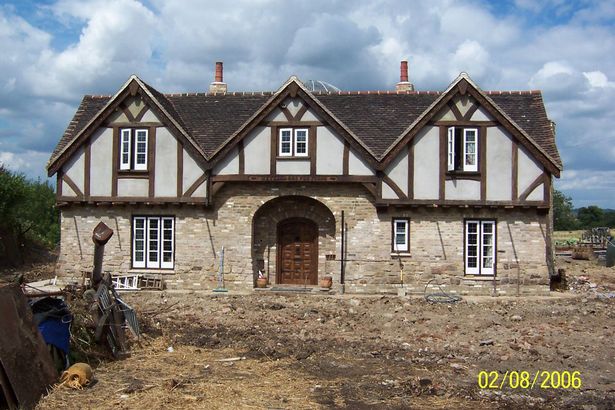
The 10 year rule refers to how long planning rules are enforced for, so after 10 years in most cases you don’t need retrospective planning permission. Theres also a 4 year threshold which we’ll explain in further detail.
This article looks at the powers within the Town and Country Planning Act 1990, to allow Local Authorities (LA) to take enforcement action. Alongside this the article will look at the relevant timeframes in which the LA can take action and on what types of development. We will also cover what happens if your development is subject to enforcement action and the remedies at hand. This article is aimed at domestic clients and typical householder projects.
Please note, we are not planning experts so if you need advice on enforcement matters, do get in touch and we can point you towards an appropriate specialist. This article serves to be a ‘light touch’ look at the ’10-year rules’ in planning, with simple summaries and hopefully easy-to-understand explanations.
What is the ’10-Year Rule’ in Planning?
The ’10-Year Rule’ for planning is a widely searched term on the internet. It does need to be explored in the context of other timeframes associated with enforcement action. Alongside the ’10-Year Rule’, there are a couple of ‘4-Year Rules’ to consider also. Therefore, if we take the information from the government website, we can see the following:
What are the time limits for taking enforcement action?
In most cases, development becomes immune from enforcement if no action is taken:
- within 4 years of substantial completion for a breach of planning control consisting of operational development;
- within 4 years for an unauthorised change of use to a single dwellinghouse;
- within 10 years for any other breach of planning control (essentially other changes of use – not dwellings).
What does this mean then? The first sentence sets out clearly, that if no enforcement action is taken (within the prescribed timeframes) then the development becomes immune from enforcement action.
The first bullet point refers to ‘operational development’, we know this to be any building work and covers pretty much all elements of construction projects. The second and third bullet points principally relate to a change of use scenarios.
To put this into a real-life scenario:
You have planning approval for a rear extension that comes out 3 meters to the rear of your semi-detached property, with neighbours close by on either side of your boundary. Before you commence construction, you decide to enlarge the extension by another metre, meaning it is now extending your house by 4 meters. The project is completed.
From the point where the project is completed, a 4-year timeframe begins, whereby if the Local Authority (LA) are made aware of the breach, then enforcement action can be taken. In this instance, it would be likely that neighbours would notice the additional metre added to the extension and object directly with the LA.
The act also gives powers to Local Authorities to act outside the timeframes, however, this only applies in cases of deliberate concealment of a planning breach. The section on the government website goes on to say that:
- where there has been deliberate concealment of a breach of planning control, local planning authorities may apply for a planning enforcement order to allow them to take action after the time limits in section 171B have expired.
- where a person has deliberately concealed a breach of planning control, the courts have found that in these circumstances, the time limits in section 171B do not engage until the breach has been discovered.
What Happens if You Build Without Planning Permission?
This section looks at the potential issues of building without planning permission or building in contravention of planning-approved drawings.
If we go back to the real-life scenario, we set out above:
The extension you enlarged is now built and the 4-year time period is now effective. The best-case scenario now is that none of your neighbours notice or object and the 4-year period passes. Should this happen and you haven’t deliberately concealed the error/enlargement then your enlarged extension would effectively be exempt from enforcement notice.
However, what happens if your neighbour does put a call to the local authority?
If we refer back to the government article, there are a list of actions available to Local Authorities (LA) on the discovery of a breach of planning permission. When a breach is highlighted to a LA, then they will create a case and contact the applicant as listed on the planning permission and explore further. The LA have the following powers:
- No formal action
- Retrospective planning application
- Planning contravention notice
- Enforcement Notice
- Planning Enforcement Order
- Stop Notice
- Temporary Stop Notice
- Breach of Condition Notice
- Injunction
- Rights of entry
- Enforcement on crown land
- Listed Building enforcement
- Enforcement of hazardous substances control
- Unauthorised advertisements
- Enforcement and protected trees
We will now analyse and explain the most relevant powers given to Local Authorities in this situation.
Example of when trying to exploit planning permission rules
In 2000, a farmer build a 4 bed detached mock-tudor house on his land without planning permission, and hid the construction for 7 years under hay bales. Hoping to take advantage of the 10 year rule and avoid the need for permission. However the house was discovered and after almost 9 years of legal proceedings, he was force to start demolishing the property as the council found it breached national and local planning rules designed to protect the green belt.
(Images: Reigate and Banstead Council)
No Formal Action
This is where a breach of planning control is addressed directly between an enforcement officer and the applicant, without having to take formal enforcement action. This would cover instances where the issues are easy to rectify or are the result of a genuine mistake. The webpage goes on to set out some examples where formal enforcement action may not be appropriate:
- there is a trivial or technical breach of control which causes no material harm or adverse impact on the amenity of the site or the surrounding area;
- development is acceptable on its planning merits and formal enforcement action would solely be to regularise the development;
- in their assessment, the local planning authority consider that an application is the appropriate way forward to regularise the situation, for example, where planning conditions may need to be imposed.
In the real-life scenario we have set out, it is possible that the 4-metre extension could be dealt with under point 2 of the above – in essence submitting a new planning approval for the change. There may also be permitted development rights that could be used around the 4-metre extension. Please see our blog post on this: insert the link.
we are not planning experts and that this article is aimed at domestic clients. Planning policy will continue to evolve and develop, so always check with current and up-to-date guidance directly from the government.
Retrospective Planning Application
As touched on in the section above, a simple solution to unauthorised development is to submit a retrospective planning application to regularise the situation. Retrospective planning applications that are submitted, should be dealt with under the usual planning consideration means by the Local Authority. The only difference is that the applicant only gets one opportunity to attain planning permission in this scenario.
As touched on in the section above, a simple solution to unauthorised development is to submit a retrospective planning application to regularise the situation. Retrospective planning applications that are submitted, should be dealt with under the usual planning consideration means by the Local Authority. The only difference is that the applicant only gets one opportunity to attain planning permission in this scenario.
As touched on in the section above, a simple solution to unauthorised development is to submit a retrospective planning application to regularise the situation. Retrospective planning applications that are submitted, should be dealt with under the usual planning consideration means by the Local Authority. The only difference is that the applicant only gets one opportunity to attain planning permission in this scenario.
As touched on in the section above, a simple solution to unauthorised development is to submit a retrospective planning application to regularise the situation. Retrospective planning applications that are submitted, should be dealt with under the usual planning consideration means by the Local Authority. The only difference is that the applicant only gets one opportunity to attain planning permission in this scenario.
The two sections set out above illustrate ‘lighter tough’ approaches from the Local Authority (LA) and cover both ‘no formal action’ and ‘formal action’ approaches to dealing with enforcement. The next series of mechanisms available to the LA, look at instances where ‘formal action’ is being utilised.
Planning Contravention Notice
When a Local Authority (LA) is made aware of a breach of planning control, they might look to issue the applicant with a Planning Contravention Notice (PCN). This is a tool used by the LA to request information from the applicant in relation to the alleged breach. The PCN is issued as a form and typically sets out a series of questions to be answered/information provided. Following receipt of a completed PCN, the LA would then deliberate over the information provided and determine the next steps.
Failing to respond to a PCN within 21 days, is an offence and would result in a fine. Furthermore, failing to respond to a PCN is likely to escalate the situation, rather than engage the LA in constructive conversations about the alleged breach – so don’t ignore them.
In the real-life scenario, the LA might choose to issue a PCN, in order to understand the reasoning behind the enlargement of the extension.
Enforcement Notice
Enforcement Notices inform the applicant that their development is in breach of planning control and sets out measures/timeframes associated with remedying the breach. It should include information on how to appeal the enforcement notice.
It is an offence not to comply with an enforcement notice within the allotted timeframe and without an appeal. Being found guilty of this, on conviction, could lead to an unlimited fine.
The Local Authority (LA) have powers to access any land that an enforcement notice is served on.
In the real-life scenario, the LA would issue an enforcement notice and it may contain a variety of suggestions, based on the severity of the breach. These could range from submitting a retrospective planning application, through to demolishing the extension, or the part of the extension that does not have consent i.e. the additional metre.
Stop Notices and Temporary Stop Notices
Both these notices allow the Local Authority (LA) to prevent activities which comprise the alleged breaches of planning control.
The difference between the two is the timeframes in which they come into effect. A temporary stop notice requires the work to be stopped immediately, whilst a stop notice usually can only apply after 3 days of the notice being served. Furthermore, a stop notice would usually follow an enforcement notice, whilst a temporary stop notice can be issued in any situation.
A temporary stop notice expires 28 days after the display of the notice on site.
Both notices restrict a lot of uses and works that occur on building sites. However, they cannot prevent a homeowner/tenants from using their property to reside in.
Summary
The information set out above looks at the most likely domestic scenarios that will encounter enforcement action. There is much more information and detail available on the government website: Enforcement and post-permission matters – GOV.UK (www.gov.uk).
If we return to the original question – ‘What is the 10-year rule in planning?’ this covers projects that exclude dwellings. Therefore, approaching the article with a viewpoint of a domestic client, the question should really be, ‘What is the 4-year rule in planning?’, to which we have answered and covered the likely ramifications if a breach of planning control is discovered within the 4 years.
Our advice would be to always seek the advice of specialists and professionals. Architects are certainly worth contacting if you have any planning concerns, as they would be able to advise you on other specialists that could assist with more detailed planning issues. These specialists would be planning consultants and solicitors with planning experience.
Finally, we would reiterate that we are not planning experts and that this article is aimed at domestic clients. Planning policy will continue to evolve and develop, so always check with current and up-to-date guidance directly from the government.



